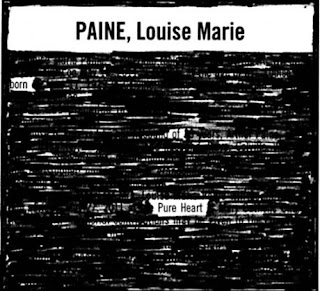
I admit I've been drawn to some odd things lately. The latest surprise fascination is with something called Newspaper Blackout as done by Austin Kleon. He uses the technique to write poetry, but I played with it a bit yesterday to reduce obituaries to an essence. Why obituaries? I spent some time with a friend Saturday who is over 80 and admitted that the first thing she reads in the newspaper is the obits. I told her she needed to find something else to read first, obits second.

So obituaries were on my mind when I perused the paper yesterday, and I've been thinking about trying this blackout thing. This seemed a good place to start, not to compose poetry, but to distill these already capsulized accounts of a person's life to an essence.
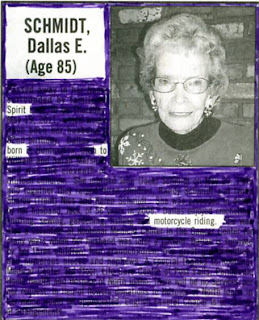
I carefully read the first one, taking in all the details (which were actually quite entertaining) before going back to search for my few chosen words. I just drew lines through the rest of the text, saving the total blacking out for later.
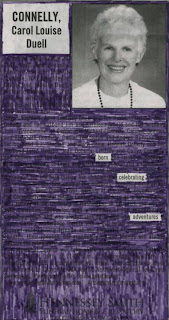
After the first few, I found I was skimming for words that would make sense together, not really reading the content as presented. My mind was engaged in a puzzle and becoming totally absorbed in the process. I soon realized how similar this was to some of the drawing on the right side of the brain exercises. Forget about what the thing is that you are looking at. Focus on bits and pieces that on their own are merely a line, a curve, a negative space, a disembodied word.
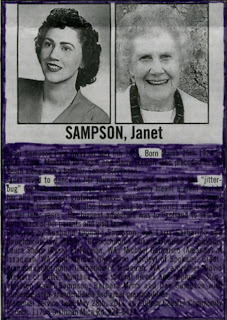
And then, when I returned to do more thorough blacking out, I realized how relaxing this process was; I really zoned out fully concentrated on the movement of the pen back and forth. I wasn't using a proper pen, I don't think, just an old felt-tip pen that was running out of ink on me, so the coverage wasn't very even. That's when I saw I could create a pattern in the blackout by making my shading lines in different directions.
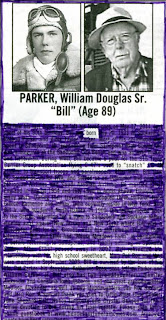
There are other ways to vary the blacking out, I discovered. Yes, creativity abounds even in this lowly exercise. All in all, I could see that this could make a great warm-up exercise to any creative project. It disengages the left brain, it makes the brain work to see beyond the obvious, and it takes one out of time. And by using obituaries, I glimpsed into strangers' lives and what may or may not have been the most important about them. And it beats the reason my 80 year old friend spends time with the obits.
You may need to click on the pictures for the larger view to see the words I chose. Also, these were all done with the same pen. The variety in shading and color is due to the way I adjusted the scans.

So obituaries were on my mind when I perused the paper yesterday, and I've been thinking about trying this blackout thing. This seemed a good place to start, not to compose poetry, but to distill these already capsulized accounts of a person's life to an essence.

I carefully read the first one, taking in all the details (which were actually quite entertaining) before going back to search for my few chosen words. I just drew lines through the rest of the text, saving the total blacking out for later.

After the first few, I found I was skimming for words that would make sense together, not really reading the content as presented. My mind was engaged in a puzzle and becoming totally absorbed in the process. I soon realized how similar this was to some of the drawing on the right side of the brain exercises. Forget about what the thing is that you are looking at. Focus on bits and pieces that on their own are merely a line, a curve, a negative space, a disembodied word.

And then, when I returned to do more thorough blacking out, I realized how relaxing this process was; I really zoned out fully concentrated on the movement of the pen back and forth. I wasn't using a proper pen, I don't think, just an old felt-tip pen that was running out of ink on me, so the coverage wasn't very even. That's when I saw I could create a pattern in the blackout by making my shading lines in different directions.

There are other ways to vary the blacking out, I discovered. Yes, creativity abounds even in this lowly exercise. All in all, I could see that this could make a great warm-up exercise to any creative project. It disengages the left brain, it makes the brain work to see beyond the obvious, and it takes one out of time. And by using obituaries, I glimpsed into strangers' lives and what may or may not have been the most important about them. And it beats the reason my 80 year old friend spends time with the obits.
You may need to click on the pictures for the larger view to see the words I chose. Also, these were all done with the same pen. The variety in shading and color is due to the way I adjusted the scans.
2 comments:
Now this I never would have thought of. But I suspect that one of these days.....
Good stuff - love the uneven coverage. This format of obit cries out for the photos to be replaced by some of your flower pix (in grayscale?), and only the person's first name to be left. Of course I'll have to copy your idea...!
Wonderful use of obits by ... who ... Gabriel Orozco - using just a few words for each - http://blog.art21.org/2008/10/09/gabriel-orozco-obit/
Post a Comment